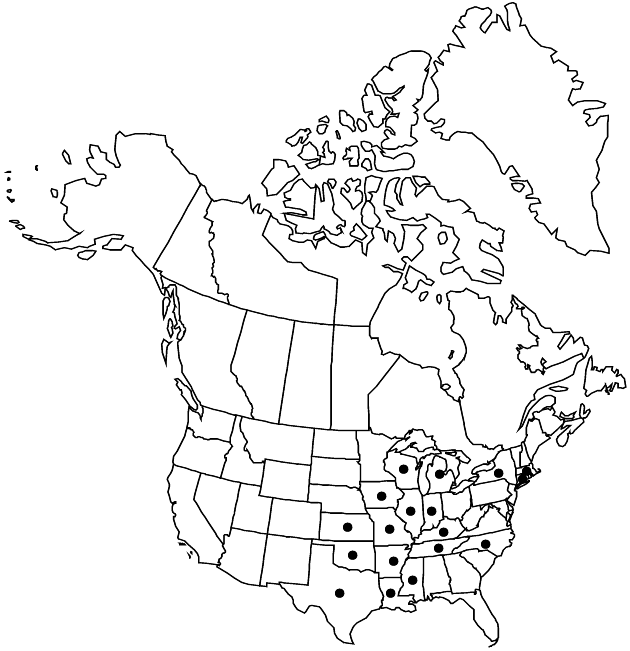Difference between revisions of "Rudbeckia subtomentosa"
Fl. Amer. Sept. 2: 575. 1813.
FNA>Volume Importer |
imported>Volume Importer |
||
| (6 intermediate revisions by 2 users not shown) | |||
| Line 8: | Line 8: | ||
}} | }} | ||
|common_names=Sweet coneflower | |common_names=Sweet coneflower | ||
| + | |special_status={{Treatment/ID/Special_status | ||
| + | |code=E | ||
| + | |label=Endemic | ||
| + | }} | ||
|basionyms= | |basionyms= | ||
|synonyms= | |synonyms= | ||
| Line 24: | Line 28: | ||
|elevation=20–300 m | |elevation=20–300 m | ||
|distribution=Ark.;Conn.;Ill.;Ind.;Iowa;Kans.;Ky.;La.;Mass.;Mich.;Miss.;Mo.;N.Y.;N.C.;Okla.;Tenn.;Tex.;Wis. | |distribution=Ark.;Conn.;Ill.;Ind.;Iowa;Kans.;Ky.;La.;Mass.;Mich.;Miss.;Mo.;N.Y.;N.C.;Okla.;Tenn.;Tex.;Wis. | ||
| − | |discussion=<p>Rudbeckia subtomentosa is often cultivated as an ornamental.</p> | + | |discussion=<p><i>Rudbeckia subtomentosa</i> is often cultivated as an ornamental.</p> |
|tables= | |tables= | ||
|references= | |references= | ||
| Line 33: | Line 37: | ||
-->{{#Taxon: | -->{{#Taxon: | ||
name=Rudbeckia subtomentosa | name=Rudbeckia subtomentosa | ||
| − | |||
|authority=Pursh | |authority=Pursh | ||
|rank=species | |rank=species | ||
| Line 47: | Line 50: | ||
|publication title=Fl. Amer. Sept. | |publication title=Fl. Amer. Sept. | ||
|publication year=1813 | |publication year=1813 | ||
| − | |special status= | + | |special status=Endemic |
| − | |source xml=https:// | + | |source xml=https://bitbucket.org/aafc-mbb/fna-data-curation/src/2e0870ddd59836b60bcf96646a41e87ea5a5943a/coarse_grained_fna_xml/V19-20-21/V21_129.xml |
|tribe=Asteraceae tribe Heliantheae | |tribe=Asteraceae tribe Heliantheae | ||
|subtribe=Asteraceae (tribe Heliantheae) subtribe Rudbeckiinae | |subtribe=Asteraceae (tribe Heliantheae) subtribe Rudbeckiinae | ||
Latest revision as of 20:09, 5 November 2020
Perennials, to 200 cm (rhizomatous, rhizomes stout). Stems densely hirsute (hairs mostly antrorse, to 0.5 mm). Leaves: blades ovate to elliptic (not lobed), margins denticulate to serrate, apices acute to obtuse or acuminate, faces densely hirsute and gland-dotted (glands fewer adaxially); basal 15–30 × 3–10 cm, bases attenuate; cauline petiolate, ovate to elliptic, proximal 3–25 × 1–15 cm, usually 3–5-lobed, bases truncate to cuneate or rounded. Heads (8–25) in loose, corymbiform to paniculiform arrays. Phyllaries to 1.5 cm (faces hairy and ± gland-dotted). Receptacles conic to hemispheric; paleae 4–6 mm, apices acute, abaxial tips hirsute and gland-dotted. Ray florets 10–16; laminae (yellow to yellow-orange) linear to oblanceolate, 20–40 × 5–8 mm, abaxially sparsely hairy, abundantly gland-dotted. Discs 10–17 × 5–15 mm. Disc florets 200–400+; corollas yellowish green on basal 1/2, otherwise brown-purple, 3–4.2 mm; style branches ca. 1 mm, apices acute. Cypselae 2–3.5 mm; pappi coroniform, to ca. 0.2 mm. 2n = 38.
Phenology: Flowering late summer–fall.
Habitat: Mesic to wet prairies, stream banks, and woodland openings
Elevation: 20–300 m
Distribution

Ark., Conn., Ill., Ind., Iowa, Kans., Ky., La., Mass., Mich., Miss., Mo., N.Y., N.C., Okla., Tenn., Tex., Wis.
Discussion
Rudbeckia subtomentosa is often cultivated as an ornamental.
Selected References
None.